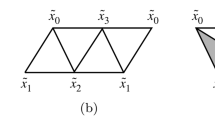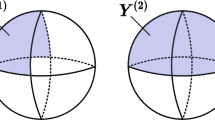Abstract
The study of comparison theorems in geometry has a rich history. In this paper, we establish a comparison theorem for polyhedra in 3-manifolds with nonnegative scalar curvature, answering affirmatively a dihedral rigidity conjecture by Gromov. For a large collections of polyhedra with interior non-negative scalar curvature and mean convex faces, we prove the dihedral angles along its edges cannot be everywhere less or equal than those of the corresponding Euclidean model, unless it is isometric to a flat polyhedron.





Similar content being viewed by others
Change history
08 February 2022
A Correction to this paper has been published: https://doi.org/10.1007/s00222-022-01104-1
Notes
The same argument here applies to the general case where the barrier B has bounded mean curvature, see Remark 2.3.
References
Aleksandrov, A.D.: A theorem on triangles in a metric space and some of its applications. Trudy Mat. Inst. Steklov. 38, 5–23 (1951)
Allard, W.K.: On the first variation of a varifold. Ann. Math. (2) 95, 417–491 (1972)
Allard, W.K.: On the first variation of a varifold: boundary behavior. Ann. Math. (2) 101, 418–446 (1975)
Ambrozio, L.: Rigidity of area-minimizing free boundary surfaces in mean convex three-manifolds. J. Geom. Anal. 25(2), 1001–1017 (2015)
Bray, H., Brendle, S., Neves, A.: Rigidity of area-minimizing two-spheres in three-manifolds. Commun. Anal. Geom. 18(4), 821–830 (2010)
Cheeger, J., Colding, T.H.: On the structure of spaces with Ricci curvature bounded below. I. J. Differ. Geom. 46(3), 406–480 (1997)
Cheeger, J., Colding, T.H.: On the structure of spaces with Ricci curvature bounded below. II. J. Differ. Geom. 54(1), 13–35 (2000)
Cheeger, J., Colding, T.H.: On the structure of spaces with Ricci curvature bounded below. III. J. Differ. Geom. 54(1), 37–74 (2000)
Cai, M., Galloway, G.J.: Rigidity of area minimizing tori in 3-manifolds of nonnegative scalar curvature. Commun. Anal. Geom. 8(3), 565–573 (2000)
Colding, T.H., Naber, A.: Sharp Hölder continuity of tangent cones for spaces with a lower Ricci curvature bound and applications. Ann. Math. (2) 176(2), 1173–1229 (2012)
Cheeger, J., Naber, A.: Lower bounds on Ricci curvature and quantitative behavior of singular sets. Invent. Math. 191(2), 321–339 (2013)
De Philippis, G., Maggi, F.: Regularity of free boundaries in anisotropic capillarity problems and the validity of Young’s law. Arch. Ration. Mech. Anal. 216(2), 473–568 (2015)
Finn, R.: Equilibrium capillary surfaces. In: Byrne, C. (ed.) Grundlehren der mathematischen Wissenschaften in Einzeldarstellungen. Springer, Berlin (1986)
Gromov, M.: Dirac and Plateau billiards in domains with corners. Cent. Eur. J. Math. 12(8), 1109–1156 (2014)
Huisken, G., Yau, S.-T.: Definition of center of mass for isolated physical systems and unique foliations by stable spheres with constant mean curvature. Invent. Math. 124, 281–311 (1996)
Lieberman, G.M.: Hölder continuity of the gradient at a corner for the capillary problem and related results. Pac. J. Math. 133(1), 115–135 (1988)
Lieberman, G.M.: Optimal Hölder regularity for mixed boundary value problems. J. Math. Anal. Appl. 143(2), 572–586 (1989)
Li, C., Mantoulidis, C.: Positive scalar curvature with skeleton singularities. Math. Ann. 374(1–2), 99–131 (2019)
Lott, J., Villani, C.: Ricci curvature for metric-measure spaces via optimal transport. Ann. of Math. (2) 169(3), 903–991 (2009)
Li, M., Zhou, X.: A maximum principle for free boundary minimal varieties of arbitrary codimension. Commun. Anal. Geom. (to appear)
Miao, P.: Positive mass theorem on manifolds admitting corners along a hypersurface. Adv. Theor. Math. Phys. 6, 1163–1182 (2003)
Micallef, M., Moraru, V.: Splitting of 3-manifolds and rigidity of area-minimising surfaces. Proc. Am. Math. Soc. 143(7), 2865–2872 (2015)
Mahmoudi, F., Mazzeo, R., Pacard, F.: Constant mean curvature hypersurfaces condensing on a submanifold. Geom. Funct. Anal. 16(4), 924–958 (2006)
Mazzeo, R., Pacard, F.: Foliations by constant mean curvature tubes. Commun. Anal. Geom. 13(4), 633–670 (2005)
Nunes, I.: Rigidity of area-minimizing hyperbolic surfaces in three-manifolds. J. Geom. Anal. 23(3), 1290–1302 (2013)
Ros, A., Souam, R.: On stability of capillary surfaces in a ball. Pac. J. Math. 178(2), 345–361 (1997)
Simon, L.: Regularity of capillary surfaces over domains with corners. Pac. J. Math. 88(2), 363–377 (1980)
Simon, L.: A strict maximum principle for area minimizing hypersurfaces. J. Differ. Geom. 26(2), 327–335 (1987)
Shi, Y., Tam, L.-F.: Positive mass theorem and the boundary behaviors of compact manifolds with nonnegative scalar curvature. J. Differ. Geom. 62(1), 79–125 (2002)
Shi, Y., Tam, L.-F.: Scalar curvature and singular metrics. Pac. J. Math. 293(2), 427–470 (2018)
Sturm, K.-T.: A curvature-dimension condition for metric measure spaces. C. R. Math. Acad. Sci. 342(3), 197–200 (2006)
Sturm, K.-T.: On the geometry of metric measure spaces. I. Acta Math. 196(1), 65–131 (2006)
Sturm, K.-T.: On the geometry of metric measure spaces. II. Acta Math. 196(1), 133–177 (2006)
Solomon, B., White, B.: A strong maximum principle for varifolds that are stationary with respect to even parametric elliptic functionals. Indiana Univ. Math. J. 38(3), 683–691 (1989)
Schoen, R., Yau, S.T.: On the structure of manifolds with positive scalar curvature. Manuscr. Math. 28(1–3), 159–183 (1979)
Jean, E.: Taylor, boundary regularity for solutions to various capillarity and free boundary problems. Commun. Partial Differ. Equ. 2(4), 323–357 (1977)
White, B.: The maximum principle for minimal varieties of arbitrary codimension. Commun. Anal. Geom. 18(3), 421–432 (2010)
Wickramasekera, N.: A sharp strong maximum principle and a sharp unique continuation theorem for singular minimal hypersurfaces. Calc. Var. Partial Differ. Equ. 51(3–4), 799–812 (2014)
Ye, R.: Foliation by constant mean curvature spheres. Pac. J. Math. 147(2), 381–396 (1991)
Acknowledgements
The author wishes to thank Rick Schoen, Brian White, Leon Simon, Rafe Mazzeo, Or Hershkovits and Christos Mantoulidis for stimulating conversations. He also wishes to thanks the referee for greatly improving the exposition. Part of this work was carried out when the author was visiting the University of California, Irvine. He wants to thank Department of Mathematics, UCI, for their hospitality.
Author information
Authors and Affiliations
Corresponding author
Additional information
Publisher's Note
Springer Nature remains neutral with regard to jurisdictional claims in published maps and institutional affiliations.
Appendix A
Appendix A
We provide some general calculation for infinitesimal variations of geometric quantities of properly immersed hypersurfaces under variations of the ambient manifold \((M^{n+1},g)\) that leave the boundary of the hypersurface inside \(\partial M\). We also refer the readers to the thorough treatment in [26] and [4] (warning: the choice of orientation for the unit normal vector field N in [4] is the opposite to ours).
We keep the notations used in Sect. 2.1 and for each \(t\in (-\varepsilon ,\varepsilon )\), we use the subscript t for the terms related to \(\Sigma _t\). Recall that \(Y=\frac{\partial \Psi (t,\cdot )}{\partial t}\) is the deformation vector field. Denote \(Y_0\) the tangent part of Y on \(\Sigma \), \(Y_0\) the tangent part of Y on \(\partial \Sigma \). Let \(v=\left\langle Y,N \right\rangle \). For \(q\in \Sigma \), let \(e_1,\ldots ,e_n\) be an orthonormal basis of \(T_q\Sigma \), and let \(e_i(t)=d\Psi _t(e_i)\). Let \(S_0,S_1\) be the shape operators of \(\Sigma \subset M\) and \(\partial M\subset M\). Precisely, \(S_0(Z_1)=-\nabla _{Z_1}N\), \(S_1(Z_2)=\nabla _{Z_2}X\). We have:
Lemma A.1
(Lemma 4.1(1) of [26], Proposition 15 of [4])
We use Lemma A.1 to calculate the evolution of the contact angle along the boundary.
Lemma A.2
Let \(\gamma \) denote the contact angle between \(\Sigma \) and \(F_j\). Then
where L is a bounded vector field on \(\partial \Sigma \).
In particular, if each \(\Sigma _t\) meets \(F_j\) at constant angle \(\gamma _j\), then on \(F_j\),
Proof
Let us fix one boundary face \(F_j\) and denote \(\gamma _j\) by \(\gamma \). By Lemma A.1,
On \(\partial M\), Y decomposes into \(Y=Y_1-\frac{v}{\sin \gamma }{\overline{\nu }}\). Notice that since \(X=\cos \gamma N+\sin \gamma N\),
We also have the vector decomposition on \(\partial M\) with respect to the orthonormal basis \({\overline{\nu }},X\):
Since \(\left\langle X,X \right\rangle =1\) along \(\partial M\), we have \(\left\langle X,\nabla _Z X \right\rangle =0\) for any vector Z on \(\partial M\). We have
Now we deal with the second and the third terms above. Notice that on \(\partial \Sigma \cap F_j\),
Thus \(A(Y_0,\nu )=A(Y_1,\nu )-(\cot \gamma ) v A(\nu ,\nu )=-\left\langle \nabla _{Y_1}N,\nu \right\rangle -(\cot \gamma ) A(\nu ,\nu )v\). On the other hand, using the vector decomposition (A.3), we find
Here L is a vector field along \(\partial \Sigma \), and \(|L|\le C=C(Y,X,\nu )\). Thus we conclude that
as desired. \(\square \)
The evolution equation of the mean curvature has been studied in many circumstances. We refer the readers to the thorough calculation in Proposition 16, [4]:
Lemma A.3
(Proposition 16 of [4]) Let \(H_t\) be the mean curvature of \(\Sigma _t\). Then
In particular, if each \(\Sigma _t\) has constant mean curvature, then
Rights and permissions
About this article
Cite this article
Li, C. A polyhedron comparison theorem for 3-manifolds with positive scalar curvature. Invent. math. 219, 1–37 (2020). https://doi.org/10.1007/s00222-019-00895-0
Received:
Accepted:
Published:
Issue Date:
DOI: https://doi.org/10.1007/s00222-019-00895-0




